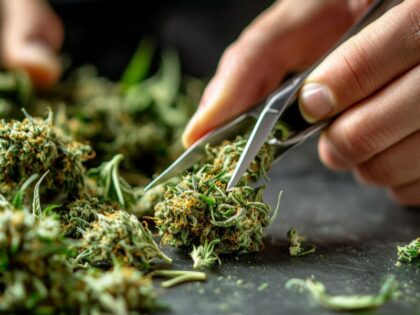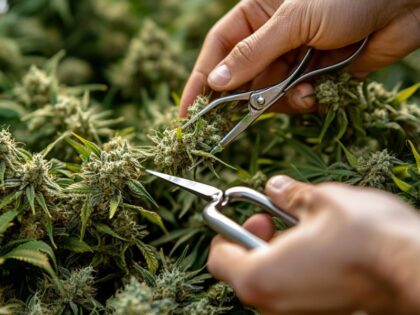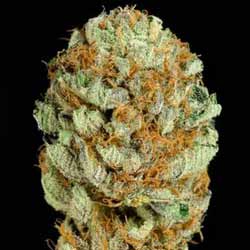Cannabis Trimming: 5 Benefits and How to Do It Properly
Trimming cannabis is a vital step in preparing the plant for consumption, affecting everything from appearance to potency. Whether you’re working with a wet trim or dry trim method, understanding the right techniques can enhance the quality of your trimmed buds and maximize the yield of your cannabis plants.
Table of Contents
Is It Important to Trim Cannabis Buds?
Yes, trimming cannabis buds is important because it improves the overall quality, potency, and appearance of the final product.
Removing excess sugar leaves and fan leaves enhances bag appeal, reduces harshness when smoked, and prevents mold during the drying process. Proper trimming also concentrates more bud by eliminating unnecessary plant material, allowing the actual buds and other cannabinoids to shine.
Benefits of Cannabis Trimming
Trimming cannabis offers several key advantages that directly impact the final product’s quality, appearance, and effectiveness. Here’s a breakdown of its primary benefits:
Improves Appearance and Bag Appeal
Trimmed buds look cleaner, more uniform, and visually appealing, which is especially important for commercial growers and dispensaries. Removing sugar leaves and small leaves enhances the natural shape and color of the cannabis flowers, making them more attractive to consumers.
Enhances Potency and Smoke Quality
By trimming away excess foliage like fan leaves and sugar leaf, you concentrate the cannabinoids and terpenes found primarily in the actual buds. This results in smoother smoke, better flavor, and a more potent experience with fewer harsh, unwanted compounds.
Reduces Moisture and Mold Risk
Trimming helps the buds dry more evenly and thoroughly, which is crucial for preventing mold growth. By removing plant material that retains moisture, such as large leaves and dense foliage, the drying process becomes more efficient and consistent.
Makes Storage Easier and Safer
Well-trimmed cannabis is easier to cure and store in airtight containers. With fewer leaves and stems taking up space or harboring excess moisture, you maintain better humidity levels and preserve the quality of your weed for longer periods.
Focuses Yield on the Good Stuff
Trimming ensures that your final dry weight is composed mostly of sticky buds rather than unnecessary plant parts. This increases the ratio of usable product and helps growers harvest cannabis with more bud and less waste.
How to Properly Trim Cannabis Buds

Trimming cannabis buds properly ensures you get the best quality product while preserving potency, flavor, and appearance. Whether you’re using hand trimming or a bowl trimmer, following the right steps makes all the difference. Here’s how to do it:
1. Prepare Your Workspace
Set up in a well ventilated area with good lighting and a clean surface. Make sure you have all tools ready: sharp scissors, disposable gloves, and containers for collecting trim and buds. Maintaining cleanliness helps avoid contamination and sticky residue buildup.
2. Choose Between Wet or Dry Trim
Decide if you want to trim right after harvest (wet trim) or after the drying process (dry trim). Wet trimming makes it easier to remove sugar leaves and handle sticky buds, while dry trimming may preserve more terpenes and is preferred by some for the appearance of trimmed buds.
3. Cut Branches from the Main Stalk
Start by cutting full branches from the main stem or whole plant. This makes handling easier and keeps the trimming process more organized. You can work with one branch at a time to focus on bud development and avoid damaging the flowers.
4. Remove Fan Leaves
Fan leaves are the large leaves that contain little to no cannabinoids. Carefully snip them away first to expose the underlying cannabis flowers. This step clears the way for a more precise trim.
5. Trim Sugar Leaves and Small Leaves
Use scissors to carefully trim all the sugar leaves and any small leaves protruding from the buds. Trim as close to the bud structure as possible without cutting into the flowers. This refines the shape and maximizes bag appeal.
6. Collect and Sort Your Buds
Separate big buds, small buds, and tiny buds. While larger buds are usually prioritized for sale or use, small buds and trim can be saved for making concentrates, edibles, or other methods of extraction involving other cannabinoids.
7. Dry and Cure for Best Results
Once the trimming job is complete, place the buds in a well-controlled environment with the right relative humidity to continue the drying process. Once completely dry, move them into airtight containers for curing to preserve flavor and potency over time.
Essential Tools for Cannabis Trimming
Having the right tools makes trimming cannabis faster, cleaner, and more effective. Here are the essentials every grower should have on hand:
- Sharp Scissors – Precision trimmers or curved-tip scissors make it easier to manage around buds and remove sugar leaves cleanly.
- Disposable Gloves – Protect your hands from sticky resin while maintaining hygiene throughout the trimming process.
- Trim Tray or Work Surface – A tray helps catch trimmed leaves and tiny buds, keeping your workspace organized and making it easier to collect the good stuff.
- Storage Containers – Use airtight containers for storing trimmed buds and separate bins for fan leaves or trim used in other methods like extracts.
- Bowl Trimmer (Optional) – For larger harvests, a mechanical bowl trimmer speeds up the process and handles more volume, though it may sacrifice some detail compared to hand trimming.
- Lighting – A bright, focused light source helps you spot small leaves and achieve a cleaner trim job.
- Cleaning Supplies – Have alcohol wipes or a blade cleaner ready to keep scissors sharp and free from buildup.
Tips to Effectively Trim Marijuana Plants

Trimming marijuana plants efficiently requires a balance of technique, patience, and attention to detail. Here are some tips to help you trim more effectively:
- Start Trimming Right After Harvest (if Wet Trimming) – Begin while the plant is still fresh to make cutting sugar leaves and small leaves easier.
- Work in Sections – Tackle one branch at a time to maintain focus and avoid damaging the flowers or losing track of tiny buds.
- Keep Tools Clean – Regularly clean scissors to prevent sticky buildup and ensure clean cuts throughout the trim job.
- Use Good Lighting and Ventilation – Proper lighting improves visibility of leaf structures, while a well ventilated area keeps you comfortable during long sessions.
- Handle Buds Gently – Minimize pressure on the buds to preserve trichomes and maintain the quality of your cannabis flowers.
- Stay Consistent – Whether you prefer wet or dry trimming, maintain a uniform trim style for a more professional finish and better bag appeal.
- Take Breaks – Trimming cannabis can be time-consuming, so pacing yourself helps maintain precision and prevents fatigue.
- Adapt to Cannabis Strains – Some strains may have denser or more resinous flowers, requiring adjustments in trimming technique and tool use.
Final Thoughts
Trimming cannabis is more than just a cosmetic step—it’s a crucial part of the harvest that directly affects quality, potency, and preservation. With the right tools, techniques, and attention to detail, trimming ensures your cannabis flowers are clean, potent, and ready for curing or consumption. For growers and enthusiasts aiming to improve the quality and appeal of their cannabis, proper trimming is a step that shouldn’t be overlooked. Whether choosing wet or dry methods, mastering trimming techniques and using the right tools can make a noticeable difference. To continue improving your cultivation skills, study additional resources on cannabis harvesting, curing, and post-harvest care
Frequently Asked Questions
How long does it take to trim cannabis by hand?
Trimming cannabis by hand can take several hours depending on experience and the amount of harvested plant material. On average, expect to spend 1–3 hours per pound of dried buds.
Can I reuse the trim from cannabis plants?
Yes, trim can be repurposed for making edibles, tinctures, concentrates, or infused oils since it still contains cannabinoids and terpenes, though in smaller amounts than buds.
What’s the best humidity level during the trimming process?
Aim for a relative humidity of 45–55% in a well ventilated area. This helps prevent mold while keeping the buds from drying too fast or becoming brittle.
Should I trim cannabis before or after drying if I’m unsure?
If you’re unsure, start with wet trimming in small batches. It’s easier to remove sugar leaves while they’re still soft, and you’ll get faster results with less effort.
Does trimming affect cannabinoid content?
Trimming itself doesn’t change cannabinoid content, but handling buds carefully during the process helps preserve trichomes, which contain THC, CBD, and other cannabinoids.
Can I use regular scissors to trim cannabis?
While regular scissors can work in a pinch, precision trimmers are recommended. They reduce hand fatigue and allow for cleaner, more accurate cuts around the buds.
Related Posts
Growing Marijuana from Seed: 9 Key Steps to Plant Maturity
How to Germinate Marijuana Seeds: 5 Easy Steps for Newbies
Cannabis Deficiency Chart: 12 Essential Weed Plant Nutrients
CATEGORIES
Best Selling Seeds











